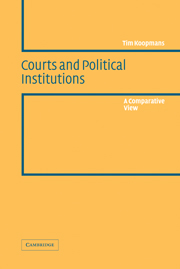Book contents
- Frontmatter
- Contents
- Preface
- Table of cases
- List of abbreviations
- 1 Introduction
- 2 The Sovereignty of Parliament
- 3 Judicial review of legislation
- 4 The growth of judicial power
- 5 The limits of judicial review
- 6 The legality of administrative action
- 7 Courts and governments
- 8 Courts and individual rights
- 9 Techniques of judicial protection
- 10 A glance at the future
- Select bibliography
- Index
9 - Techniques of judicial protection
Published online by Cambridge University Press: 26 February 2010
- Frontmatter
- Contents
- Preface
- Table of cases
- List of abbreviations
- 1 Introduction
- 2 The Sovereignty of Parliament
- 3 Judicial review of legislation
- 4 The growth of judicial power
- 5 The limits of judicial review
- 6 The legality of administrative action
- 7 Courts and governments
- 8 Courts and individual rights
- 9 Techniques of judicial protection
- 10 A glance at the future
- Select bibliography
- Index
Summary
Filling the gaps
Constitutional provisions, in particular those on human rights, tend to use lapidary expressions. Their actual wording is not always very helpful to those who wish to understand their meaning, as a German author once put it. Some provisions will at the least have a hard core that leaves no room for ambiguities: ‘freedom of the press’, although uncertain in its exact scope, is a term that admits no censorship of the press by the government. Other constitutional provisions, however, use a terminology where the words themselves can contribute only a little to the definition of the meaning. Expressions like ‘human dignity’ or ‘due process of law’ do not convey a definite legal meaning by themselves. Problems of interpretation therefore have a great importance in constitutional law.
Some authors try to deny or to minimize that importance. According to Justice Scalia, in his efforts to combat activist attitudes with regard to the US Constitution, it would be contrary to democracy for unelected judges to decide what the law ought to mean, as its meaning should quite simply be founded on the text of the relevant provisions. In case of a venerable constitutional document like the US Constitution, it might be necessary to give old words and phrases a broad rather than a narrow meaning, but ‘not an interpretation that the language will not bear’. This sounds like good advice, but it is not very helpful in difficult cases.
- Type
- Chapter
- Information
- Courts and Political InstitutionsA Comparative View, pp. 223 - 251Publisher: Cambridge University PressPrint publication year: 2003

